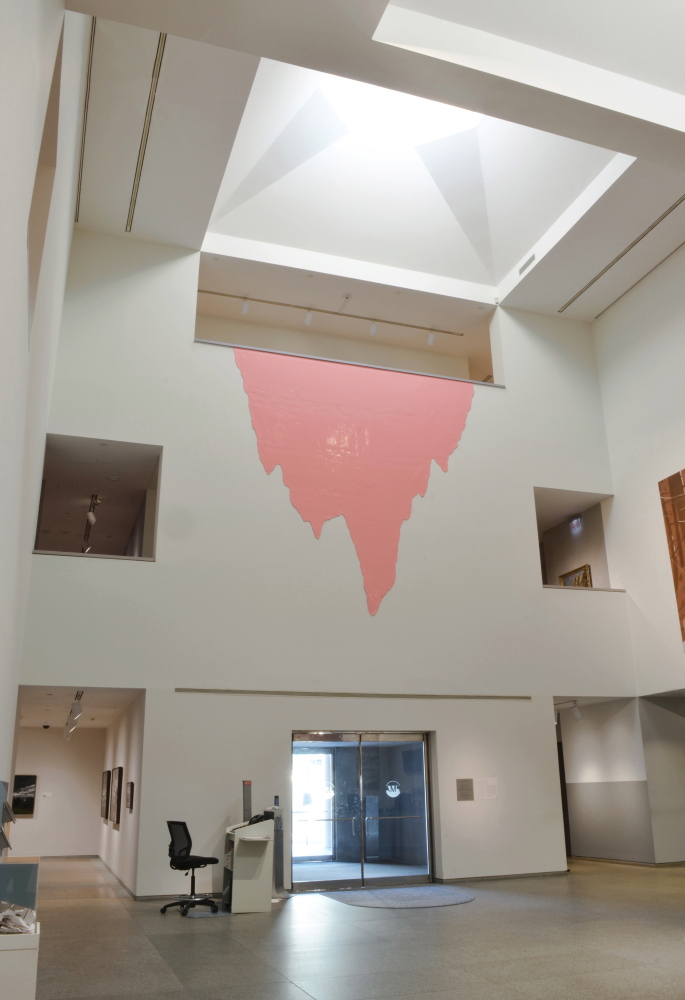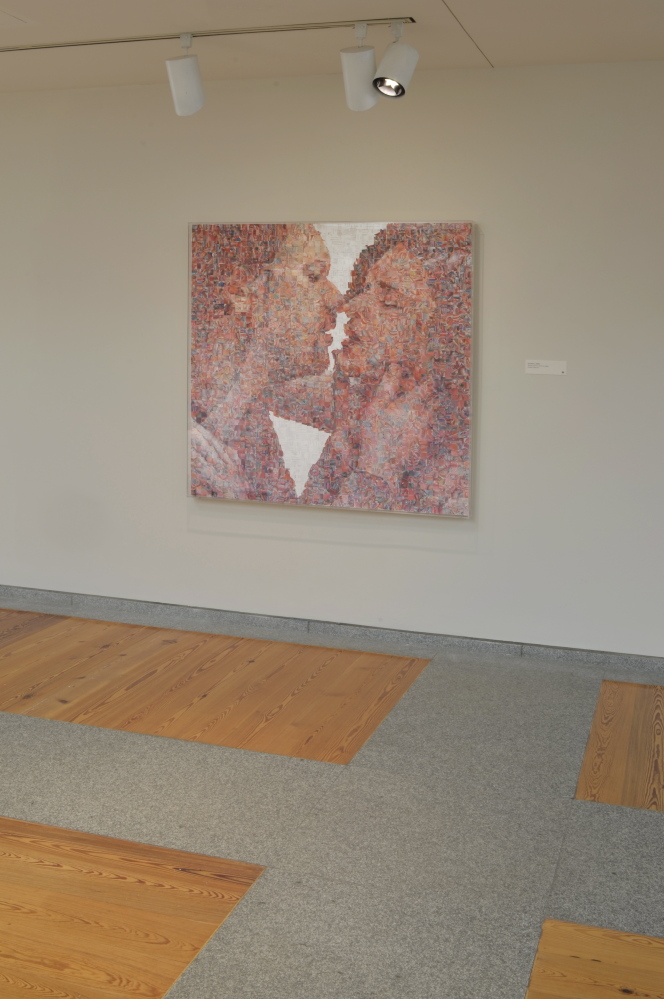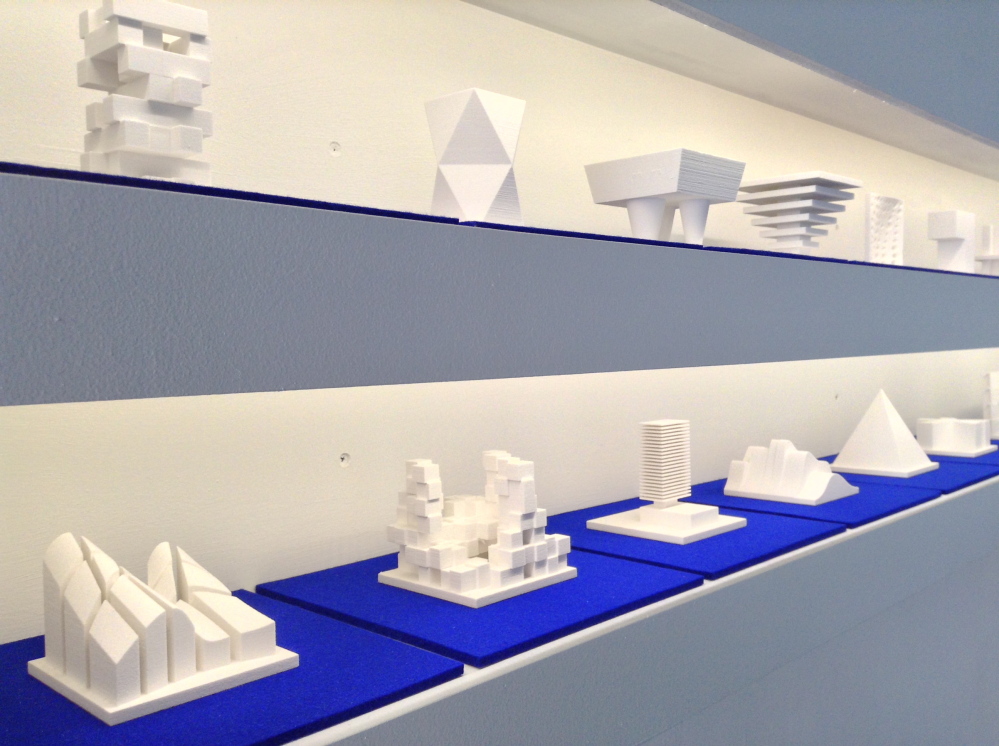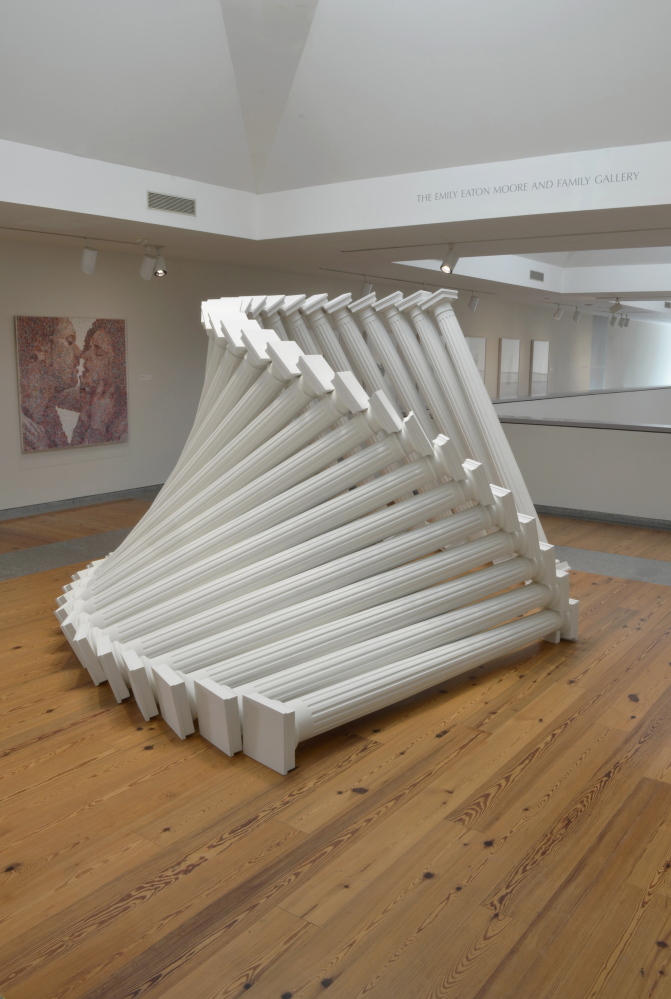There is a terrifically pithy quote that has been attributed to Picasso – most notably by Steve Jobs: “Good artists copy. Great artists steal.” The original (and decidedly less pithy) version appears to be from an 1892 text by W.H. Davenport Adams about the poet Tennyson: “That great poets imitate and improve, whereas small ones steal and spoil.”
Is it interesting that Adams’ text was about how Tennyson (and Adams himself) disapproved of plagiarism.
But what is more interesting is the shift in outcomes through the ages: Tennyson via Adams goes from “spoil” to “improve,” while Jobs goes from “good” to “great.”
It’s not plagiarism to lie about the source of a polished-up quote. It’s closer to appropriation or the newish art idea of “repurposing.” Whatever it is, it is the titular subject of Aaron T Stephan’s exhibition “To Borrow, Cut, Copy, and Steal” at the Portland Museum of Art.
The most interesting part of the show is the title. To really nail down his point, Stephan’s exhibition mostly features work that has already been shown. (Conceptually apt or lazy? You decide.)
While that is disappointing, Stephan’s show inspired the loudest laugh I have ever had at the PMA: Stephan’s giant Pepto-Bismol “drip” from the third-floor balcony in the Great Hall looks like a direct (and valid) response to the vapid, grinning figure of the giant Alex Katz painting hanging next to it. (The snarky Stephan appears to be using the architectural term for the type of exit over which the piece is hung to make a witty comment: It’s called a vomitorium.)
This does raise questions about the extent to which the Stephan is actively engaged in the collateral content of his work. I raved about the “Girl with a Pearl Earring” prints when they were shown at Aucociso and published a photograph of them (and the pedestals on view in the PMA’s Great Hall) in a 2013 review of Stephan at Coleman Burke, but to see them here – again – is frustrating. At some point, something borrowed becomes something old.
We’ve seen the other works elsewhere, too, like “28 Columns” at the Farnsworth. And we saw Stephan’s repurposed anatomy book piece in 2006 at Whitney Art Works. Even then it was a prosaic version of something often seen in the front of magazines (and student studios) that comprises many smaller images as pixels. (My favorite versions were by Seattle artist Deborah Coito, who coded her own program to reconstitute digital images with thousands of hardcore porn thumbnails she pulled off the Internet.) And since the freshness of the idea is very much the point of concept-driven art like this, it’s disappointing to recognize the work has been done often – and often better – by others.
Stephan’s commissioned piece for the show, three five-minute recordings of him talking to sex phone workers about art (Sherrie: “I think Thomas Kincaid is pretty awesome”), is completely eclipsed by, among other examples, Christian Jankowski’s recordings of television fortune tellers taking calls about the upcoming 1999 Venice Biennale at which the piece was shown. The most interesting part of “Conversations” is gathering your own thoughts about the ethics of Stephan’s saying to the phone workers when they ask what kind of art he does: “I am a sculptor.”
If you haven’t seen Stephan’s work in the flesh, it’s possibly worth a visit. But while the phone recordings are tinny and scrapy (both in sound and substance), it is art you can experience from home: Just call (207) 228-0300 and then enter 401, 402 and 403 to hear each segment.
Ironically, the Stephan show is a great counterpart to “Fair Use” now on view at the Institute of Contemporary Art at Maine College of Art. “Fair Use” is a brilliant installation by Project_, a firm co-founded by Massachusetts Institute of Technology architecture faculty member Ana Miljacki and Vassalboro native Lee Moreau in 1998.
It is about appropriation in architecture and is split into two main components. One is a timeline of key points in the legal and cultural history of appropriation and copyright. The other is a set of four shelves, each with 10 tropes, or repeated set pieces, of architecture accompanied by a listing at least three instances in which the form was used.
What makes “Fair Use” so satisfying is the fact that it is set up to foster discussion and learning about its subject. It was, after all, the product of an MIT seminar, and it is now being presented at MECA. Instead of the uncomfortable mumble of “how many times have we seen this before?” inspired by Stephan’s show, “Fair Use” is fueled by the phenomenon of recognition. It creates a lexicon of architectural form – for us – by being historically rigorous.
The 40 models on display look white and sleek but reveal enough of their material presence up close to become exquisite, highly fragile and likely irreplaceable. What takes “Fair Use” from interesting to extraordinary is the dialogue established between these intriguing objects, their phenomenal presentation and the important issues of appropriation, including copyright, repurposing, borrowing, stealing and imitating, etc.
Complementing “Fair Use” is “Project_Rorschach,” featuring a video projection, a furniture-like structure on which are placed 10 sets of cards and 10 large wall prints of architectural forms mashed up to look like the original Rorschach prints, which were carefully guarded and made only on one special press in Switzerland.
It’s a handsome installation that feels less cold once you have spent some time with “Fair Use.” But I have to say that it felt like a breath of fresh, honest air when I visited it after seeing Stephan’s show at the PMA. The “Project_” installations acknowledge that the viewer can’t help but bring scads of subconscious collateral content to the experience.
Whether or not he was lying, repurposing or whatever, I like the message in Steve Jobs’ fake Picasso quote: There is no culture if we don’t try to incorporate the past as a means to move forward.
Freelance writer Daniel Kany is an art historian who lives in Cumberland. Contact him at:
dankany@gmail.com
Twitter: @dankany
Send questions/comments to the editors.






Success. Please wait for the page to reload. If the page does not reload within 5 seconds, please refresh the page.
Enter your email and password to access comments.
Hi, to comment on stories you must . This profile is in addition to your subscription and website login.
Already have a commenting profile? .
Invalid username/password.
Please check your email to confirm and complete your registration.
Only subscribers are eligible to post comments. Please subscribe or login first for digital access. Here’s why.
Use the form below to reset your password. When you've submitted your account email, we will send an email with a reset code.